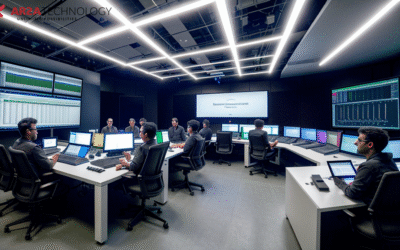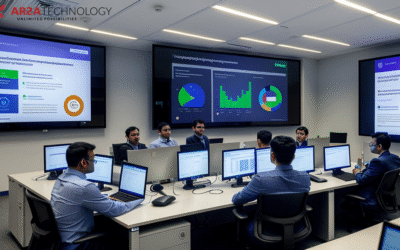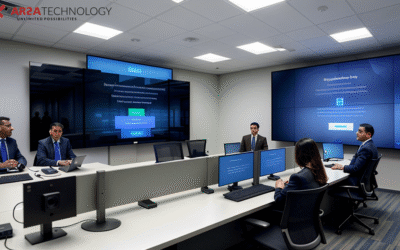Introduction: Overcoming API Integration Complexity in the Security Industry
In today’s interconnected world, robust physical access control is paramount for safeguarding assets, personnel, and sensitive information. Traditional methods, while foundational, are increasingly augmented by advanced biometric solutions like face recognition, offering unparalleled security and convenience. However, for many organizations in the security sector, the journey to integrate these powerful technologies into existing infrastructure can be fraught with challenges. The complexity of API integration often stands as a significant hurdle, delaying deployment, increasing costs, and potentially introducing vulnerabilities if not handled correctly.
ARSA Technology understands these integration complexities. Our mission is to empower businesses with high-performance AI API products that are not only cutting-edge but also designed for streamlined, secure implementation. This article delves into the critical security best practices for implementing a Face Recognition API, specifically for physical access control management, ensuring that your transition to a biometric-driven security paradigm is both efficient and impenetrable.
The Imperative of Fortified Biometric Security in Access Control
Physical access control systems are the first line of defense for any facility. When integrating a Face Recognition API, the stakes are incredibly high. A compromised system can lead to unauthorized access, data breaches, and significant operational disruptions. Therefore, security cannot be an afterthought; it must be woven into every layer of the integration process, from initial design to ongoing maintenance.
The benefits of a well-implemented face recognition system for access control are clear: enhanced security, faster authentication, and a frictionless user experience. However, achieving these benefits requires a deep commitment to security best practices, ensuring that the technology itself becomes a strength, not a potential weakness.
Designing for Robustness: Architectural Considerations for Secure Integration
A secure Face Recognition API implementation begins with a well-thought-out architectural design. This involves more than just connecting an API; it requires a holistic approach to data flow, authentication, and system resilience.
1. Secure Data Transmission: All communication between your application and the Face Recognition API must be encrypted. Utilizing industry-standard protocols like HTTPS (TLS 1.2 or higher) is non-negotiable. This prevents eavesdropping and ensures that sensitive biometric data, even if transient, is protected during transit.
2. Strong Authentication and Authorization: Access to the Face Recognition API should be strictly controlled. Implement robust API key management, OAuth 2.0, or similar token-based authentication mechanisms. Keys should be securely stored, rotated regularly, and never hardcoded into client-side applications. Authorization policies should ensure that only authorized applications and users can perform specific actions, adhering to the principle of least privilege.
3. Data Minimization and Anonymization: While the Face Recognition API processes facial data, your internal systems should strive to minimize the storage of raw biometric templates. Where possible, store only anonymized or hashed representations. This reduces the impact in case of a data breach. ARSA Technology’s API is designed to handle the core processing securely, allowing you to focus on managing identifiers rather than raw biometric data.
4. Error Handling and Logging: Implement comprehensive error handling to gracefully manage API failures without exposing sensitive system information. Detailed logging of API calls, access attempts, and system events is crucial for auditing, incident response, and identifying potential security anomalies.
Leveraging ARSA’s Face Recognition API for Enhanced Security
ARSA Technology’s Face Recognition API offers secure identity verification solutions designed to simplify integration while maintaining the highest security standards. Our API is built on a foundation of robust infrastructure and advanced AI algorithms, providing accurate and reliable facial recognition capabilities essential for physical access control.
To see the API in action and understand its capabilities for your access control needs, you can try the Face Recognition API on RapidAPI. This interactive demo allows you to explore its functionality in a controlled environment, demonstrating how it can be seamlessly integrated into your security ecosystem without the burden of managing complex underlying AI models. Our API abstracts away the intricate details, allowing your developers to focus on building secure, high-value applications.
Mitigating Common Threats: Beyond Basic Integration
Beyond the foundational architectural considerations, specific threats to biometric systems require proactive mitigation strategies.
1. Anti-Spoofing and Liveness Detection: One of the most critical threats to face recognition systems is presentation attacks, or “spoofing,” where an unauthorized individual attempts to bypass the system using a photograph, video, or 3D mask. Integrating anti-spoofing measures is vital. ARSA Technology addresses this by offering complementary solutions like our Face Liveness Detection API. By integrating this alongside face recognition, you add a crucial layer of defense, preventing fraud with liveness detection by verifying that a live person is present at the point of authentication, not just an image. This significantly enhances the integrity of your physical access control.
2. Replay Attack Prevention: Ensure that API requests cannot be intercepted and replayed by malicious actors. Implement mechanisms like nonce values, timestamping, and request signing to validate the authenticity and freshness of each API call.
3. Regular Security Audits and Penetration Testing: Proactively identify vulnerabilities by conducting regular security audits and penetration tests on your integrated system. This includes both your application layer and the interaction with the Face Recognition API. External security experts can provide an unbiased assessment of your system’s resilience.
Operational Security and Compliance: Sustaining a Secure Environment
Security is an ongoing process, not a one-time setup. Maintaining a secure Face Recognition API implementation requires continuous vigilance and adherence to operational best practices.
1. Continuous Monitoring: Implement real-time monitoring of your API usage, system logs, and network traffic. Look for unusual patterns, repeated failed access attempts, or spikes in API calls that could indicate a security incident. Automated alerts can significantly reduce response times.
2. Incident Response Plan: Develop and regularly test a comprehensive incident response plan. This plan should outline the steps to take in the event of a security breach, including containment, eradication, recovery, and post-incident analysis.
3. Compliance with Data Protection Regulations: Depending on your geographical location and the nature of the data you handle, compliance with regulations like GDPR, CCPA, and others is crucial. Understand the requirements for biometric data handling, consent, and data subject rights, and ensure your implementation aligns with these mandates. ARSA Technology designs its APIs with security and privacy in mind, helping you meet these stringent requirements.
4. Secure Development Lifecycle (SDL): Integrate security considerations into every phase of your software development lifecycle. From requirements gathering and design to coding, testing, and deployment, security should be an inherent part of the process.
Conclusion: Your Next Step Towards a Solution
Implementing a secure Face Recognition API for physical access control management doesn’t have to be a complex undertaking. By adhering to these security best practices and leveraging powerful, developer-friendly solutions like ARSA Technology’s Face Recognition API, organizations can overcome integration challenges and build robust, future-proof security systems. Our commitment to high performance and stringent security standards ensures that you can deploy advanced biometric solutions with confidence, enhancing your operational efficiency and fortifying your physical security posture.
Take the next step in securing your access control infrastructure. Explore ARSA Technology’s suite of AI APIs and discover how our solutions can simplify your integration journey while delivering unparalleled security and performance.
Ready to Solve Your Challenges with AI?
Discover how ARSA Technology can help you overcome your toughest business challenges. Get in touch with our team for a personalized demo and a free API trial.






